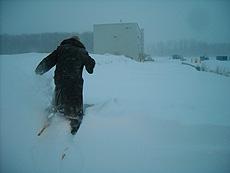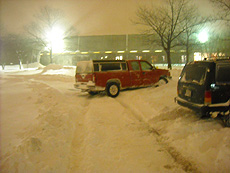Blizzard shows spirit of accelerator, detector crews
 |
Chris Olsen uses snowshoes to make his way around the lab during the blizzard. Photo Courtesy of Darren Crawford. |
Media and town officials said it was too dangerous to be outside; stay home, they said; enjoy a rare adult snow day. Schools closed, businesses closed, postal delivery ceased.
But operation of the Tevatron did not.
Amidst the worst blizzard in decades on Feb. 1-2, with nearly 15 inches of snow and more than 50 mph winds producing even higher drifts, the crews that keep Fermilab's accelerators, detectors and cryogenic systems running showed up for work. They brought extra food and clothes, snow shoes and a determined attitude that bad weather would not best them.
Think of the accelerator operators as the Marine Corp. of science: they do the job when no one else wants to; they are the first line of defense. The accelerator complex never ever sleeps, even with the rest of the U.S. under a blanket of snow. Shutting it down would require lengthy, ramped up restart periods.
"You can't just turn it off," said Dan Johnson, head of the Accelerator Division's Operations Department. "Even when the accelerators aren't accelerating beam all the support systems have to run. The Tevatron has to stay cold, we still need vacuum, we still need water. If you're not careful, the accelerator tunnel could flood.
"We just knew they were going to be here if they had to walk in with snow shoes on," Johnson, said of the operators. "It presented a challenge and they love a challenge so they just handled it."
And boy did they have challenges.
Some started work early to avoid getting trapped in unplowed roads and missing their midnight shifts; others stayed late to cover for employees who lived far away and couldn't make it in. Some such as Aron Soha at CDF and Darren Crawford in the Main Control Room put in 15-to 18-hour shift, catching brief respites of shut eye in out of the way rooms.
At 4 a.m. at the height of the blizzard with blowing snow nearly erasing the roadways, the Main Control Room got a call from the Meson Test Beam area from an experimenter who had struggled in from the village and said he was ready to take beam.
"That was a jaw dropper," said Crawford, operator crew chief that night.
What was not surprising was the lack of complaining. People stayed positive, watching the weather and joking about how they beat it. Managers called in from home to check on employees throughout the lab and the Main Control Room crew made wellness check calls to CDF and DZero. The detector crews monitored the Main Control Room logbook as two operators braved the cold and near white-out conditions to attempt repairs.
A safety detector shut off near MiniBooNE, immediately halting the beam in the Main Injector. Crews feared blowing snow had shorted it out.
 |
| Blizzard snow makes getting around and to the laboratory difficult. Photo: Courtesy of Darren Crawford.
|
Checking it meant someone had to trudge halfway across the lab, in the dark, blowing snow and below-zero temperatures. A 5-minute drive turned in to 20 minutes. With only the main road plowed, operator Chris Olson had to strap on snow shoes and tramp about 30 yards through uneven snow-filled terrain to find the detector, open it, unwrap the electronics and check it.
After more than 15 minutes freezing minutes, he discovered the detector hardware was fine; the problem was with the electronics card in the nice, warm service building. It turned out snow lightening had shorted out the system.
The FESS HV engineer couldn't get to the lab through the snow until the next morning. Then operators and FESS and Roads and Grounds personnel helped shovel a path for them to electrical boxes and hand-hauled equipment through parking lots buried in snow. First power to the Village was restored; then the Main Injector. AD interlock technicians arrived to replace a card and get the MiniBooNE safety detector back online.
Even though the Main Injector had been shut down, the last shot of protons and antiprotons before the outage continued to circle the Tevatron through the storm and beyond, providing data for CDF and DZero to analysis for 49 hours.
"We called it the little store that could," Crawford said.
-- Tona Kunz
|